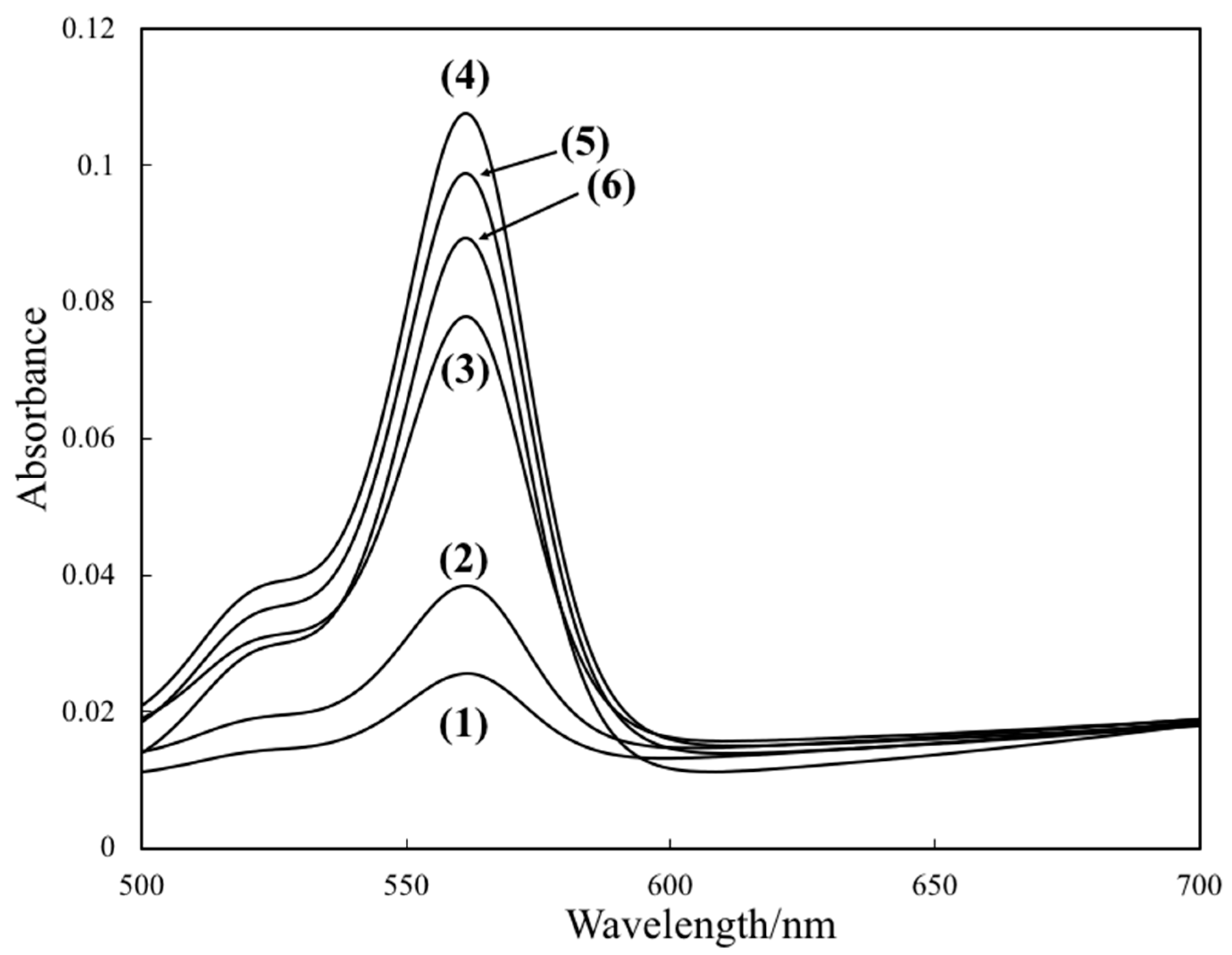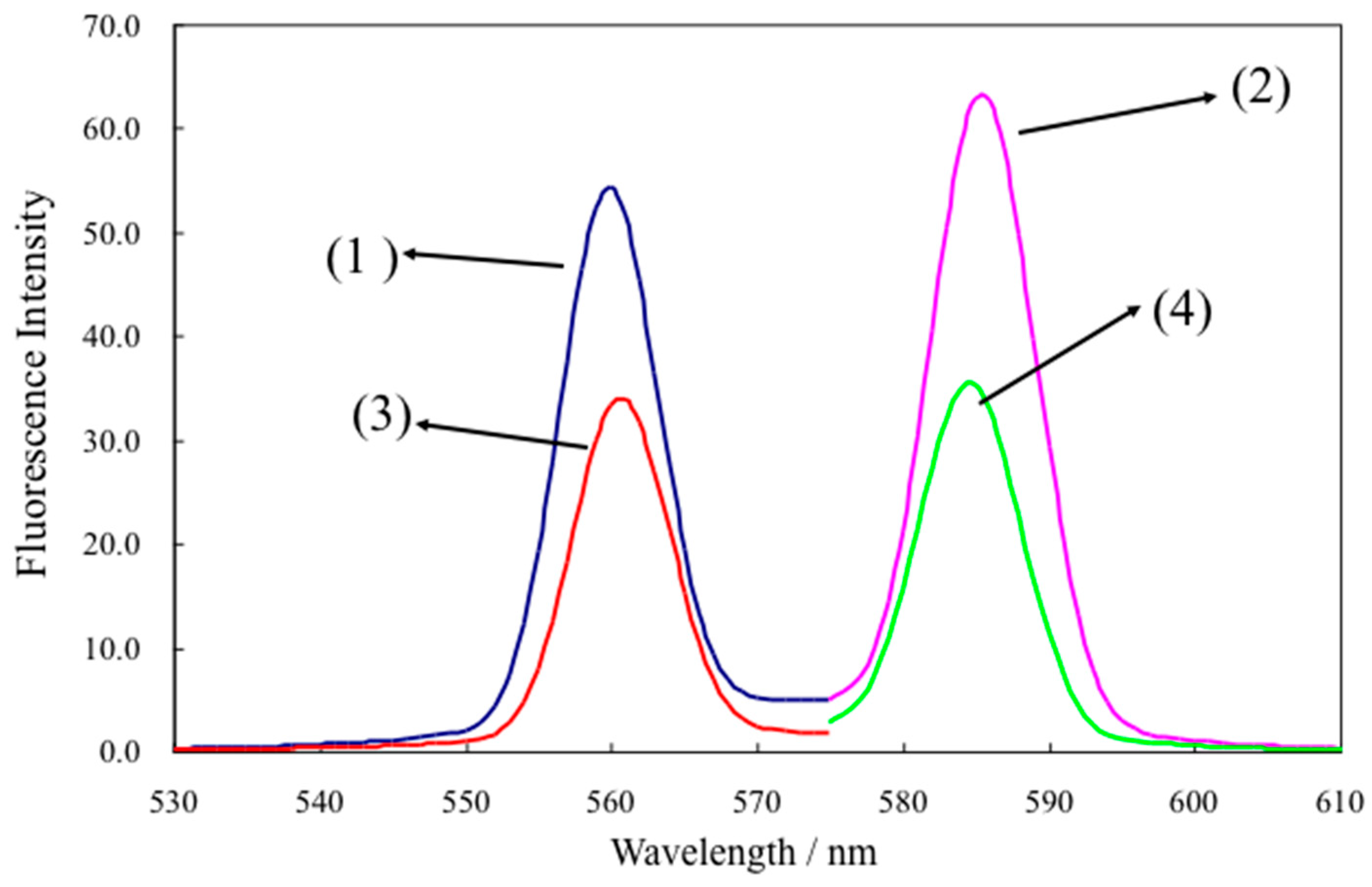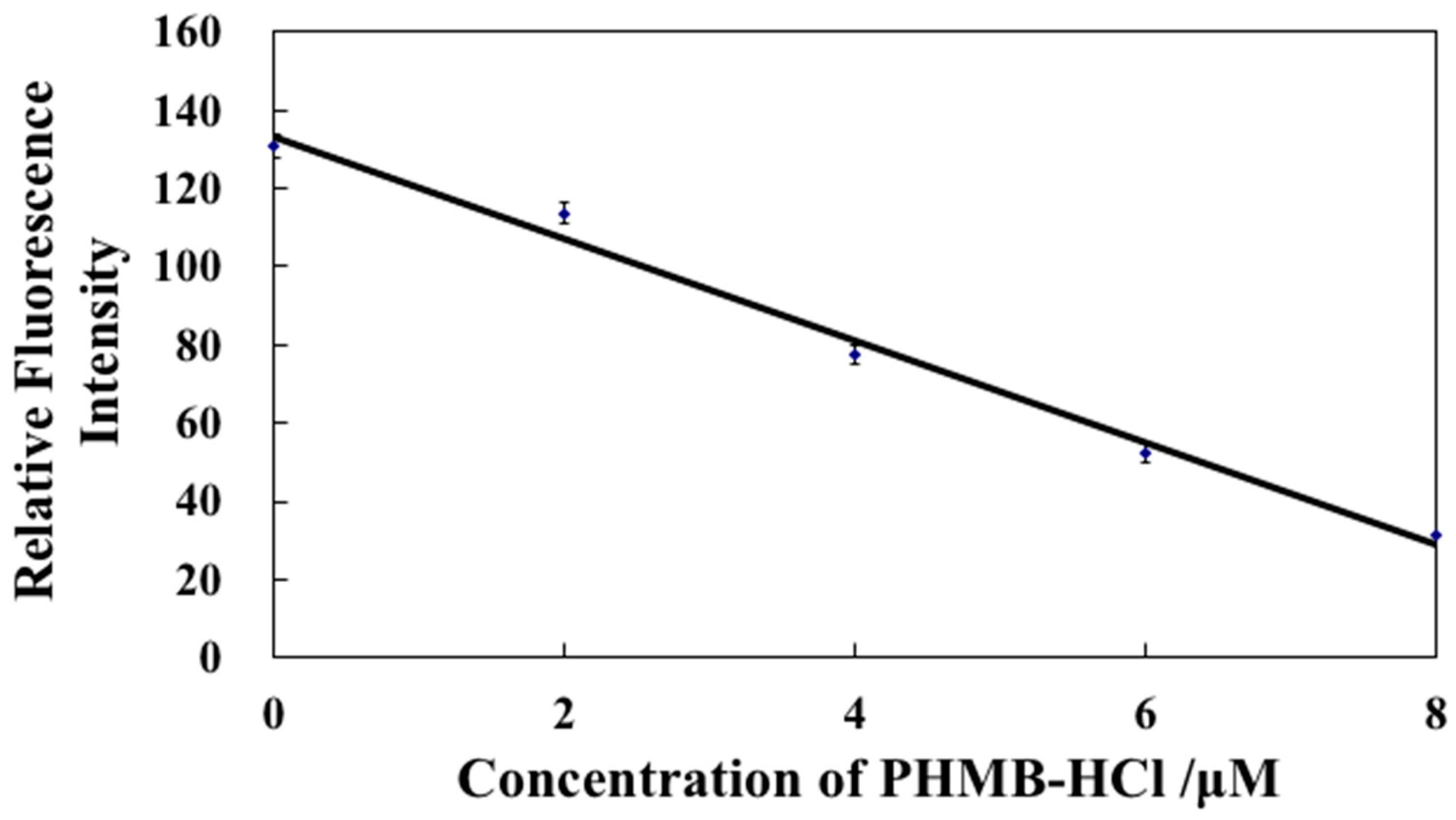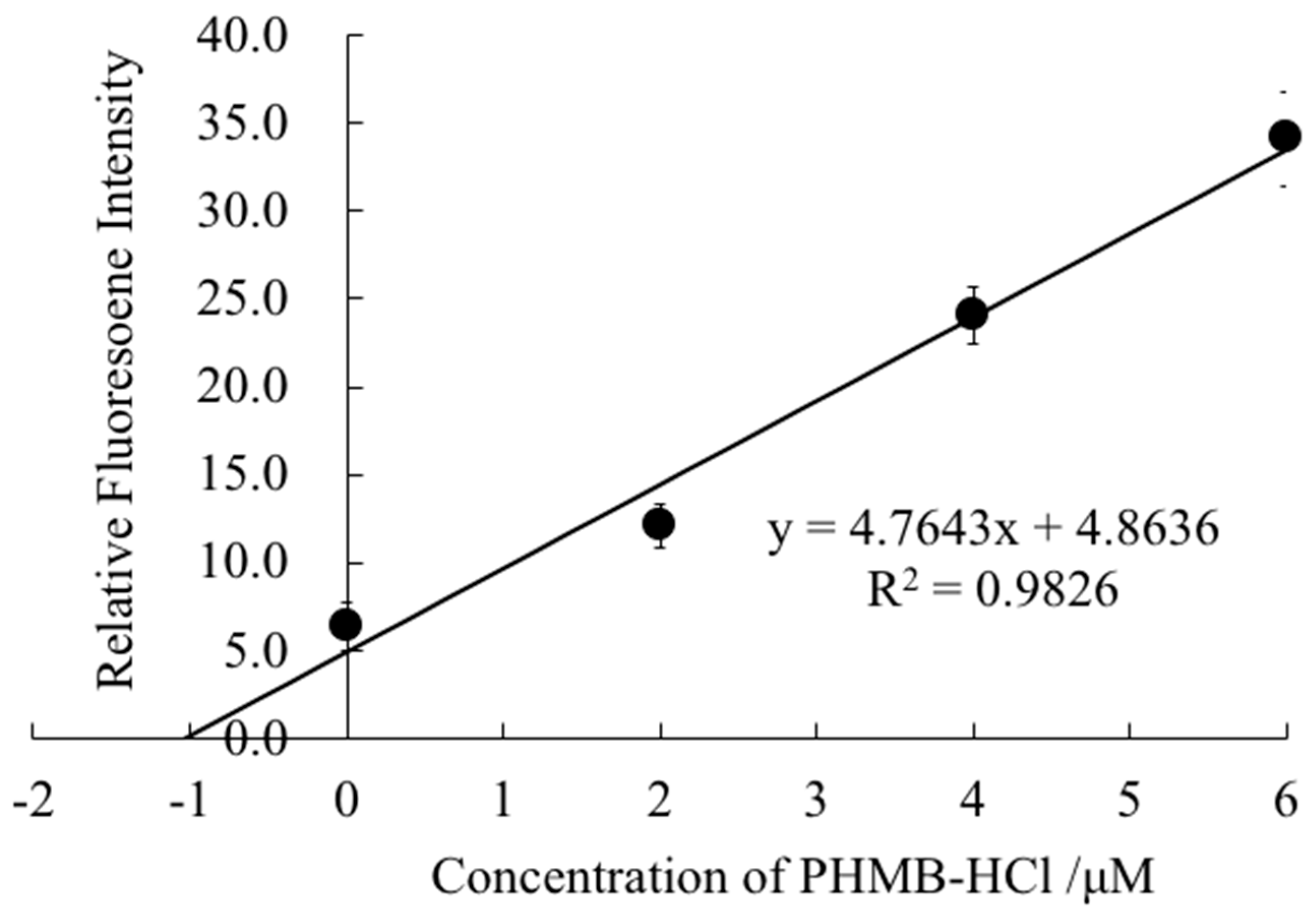Determination of Polyhexamethylene Biguanide Hydrochloride Using a Lactone-Rhodamine B-Based Fluorescence Optode
Abstract
1. Introduction
2. Results and Discussion
2.1. Absorption Spectra, Excitation, and Fluorescence Spectra of an L-RB Film after Immersing to a NaTPBF Solution
⇄ (L-RB-H+-TPBF−)memb (high fluorescence intensity)
2.2. Calibration Curve for PHMB
2.3. Evaluation of the Removal of PHMB by Using Several Solid-Phase Extraction Columns
2.4. Determination of PHMB in the CLDs
3. Experimental
3.1. Reagents
3.2. Preparation of Optode Film Containing L-RB
3.3. Evaluation of Removal of PHMB by Using Several Solid-Phase Extraction Columns with a Flow Injection Analysis (FIA)
4. Conclusions
Author Contributions
Funding
Acknowledgments
Conflicts of Interest
References
- Abad-Villar, E.M.; Etter, S.F.; Thiel, M.A.; Hauser, P.C. Determination of chlorhexidine digluconate and polyhexamethylene biguanide in eye drops by capillary electrophoresis with contactless conductivity detection. Anal. Chim. Acta 2006, 561, 133–137. [Google Scholar] [CrossRef]
- Masadome, T.; Hattori, T. Determination of polyhexamethylene biguanide hydrochloride. Rev. Anal. Chem. 2014, 33, 49–57. [Google Scholar] [CrossRef]
- Kusters, M.; Beyer, S.; Kutscher, S.; Schlesinger, H.; Gerhartz, M. Rapid, simple and stability-indicating determination of polyhexamethylene biguanide in liquid and gel-like dosage forms by liquid chromatography with diode-array detection. J. Pharm. Anal. 2013, 3, 408–414. [Google Scholar] [CrossRef] [PubMed]
- Lucas, D.; Gordon, E.A.; Stratmeyer, M.E. Analysis of polyhexamethylene biguanide in multipurpose contact lens solutions. Talanta 2009, 80, 1016–1019. [Google Scholar] [CrossRef] [PubMed]
- Hattori, T.; Nakata, Y.; Kato, R. Determination of biguanide groups in polyhexamethylene biguanide hydrochloride by titrimetric methods. Anal. Sci. 2003, 19, 1525–1528. [Google Scholar] [CrossRef] [PubMed]
- Hattori, T.; Tsurumi, N.; Kato, R.; Nakayama, M. Adsorptive voltammetry of 2-(5-Bromo-2-pyridyl) azo-5-[N-n-propyl-N-(3-sulfopropyl) amino]phenol on a carbon paste electrode in the presence of organic cations and polycation. Anal. Sci. 2006, 22, 1577–1580. [Google Scholar] [CrossRef] [PubMed]
- Rowhani, T.; Lagalante, A.F. A colorimetric assay for the determination of polyhexamethylene biguanide in pool and spa water using nickel–nioxime. Talanta 2007, 71, 964–970. [Google Scholar] [CrossRef] [PubMed]
- Ziolkowska, D.; Syrotynska, I.; Shyichuk, A. Quantitation of polyhexamethylene biguanide by photometric titration with Naphthol Blue Black dye. Polimery 2014, 59, 160–164. [Google Scholar] [CrossRef]
- Masadome, T.; Yamagishi, Y.; Takano, M.; Hattori, T. Potentiometric titration of polyhexamethylene biguanide hydrochloride with potassium poly (vinyl sulfate) solution using a cationic surfactant-selective electrode. Anal. Sci. 2008, 24, 415–418. [Google Scholar] [CrossRef] [PubMed]
- Masadome, T.; Miyanishi, T.; Watanabe, K.; Ueda, H.; Hattori, T. Determination of polyhexamethylene biguanide hydrochloride using photometric colloidal titration with crystal violet as a color indicator. Anal. Sci. 2011, 27, 817–821. [Google Scholar] [CrossRef] [PubMed]
- Masadome, T.; Oguchi, S.; Kobayashi, T.; Hattori, T. Flow injection spectrophotometric Determination of polyhexamethylene biguanide hydrochloride in contact-lens detergents using Anionic Dyes. Curr. Anal. Chem. 2018, 14, 446–451. [Google Scholar] [CrossRef]
- Uematsu, K.; Shimozaki, A.; Katano, H. Determination of polyhexamethylene biguanide utilizing a glucose oxidase enzymatic reaction. Anal. Sci. 2019, 35, 1021–1025. [Google Scholar] [CrossRef] [PubMed]
- Masadome, T.; Asano, Y. Flow injection determination of cationic polyelectrolytes using a tetraphenylborate-selective electrode detector. Bunseki Kagaku 1999, 48, 515–518. [Google Scholar] [CrossRef]
- Masadome, T.; Imato, T.; Itoh, S.; Asano, Y. Flow injection determination of anionic polyelectrolytes using an anionic surfactant-selective plasticized poly (vinyl chloride) membrane electrode detector. Fresenius J. Anal. Chem 1997, 357, 901–903. [Google Scholar] [CrossRef]
- Masadome, T.; Akatsu, M. Optical sensor of anionic surfactants using solid-phase extraction with a lactone-form Rhodamine B membrane. Anal. Sci. 2008, 24, 809–812. [Google Scholar] [CrossRef] [PubMed]
- Masadome, T.; Nakamura, Y.; Maruyama, K. Fluorescence optical sensing of anionic surfactants using a lactone-form Rhodamine B membrane. Bunseki Kagaku 2017, 66, 699–702. [Google Scholar] [CrossRef]
- Sato, R.; Yamada, R.; Masadome, T. Development of an optode detector for determination of anionic surfactants by flow injection analysis. Anal. Sci. 2019. [Google Scholar] [CrossRef] [PubMed]
Sample Availability: Not available. |





| Solid-Phase Extraction Column | Concentration of Adsorbed PHMB Column | Removal of PHMB in from the Column/% |
|---|---|---|
| Sep-Pak Plus CN | 6.0 μM | 100 |
| Sep-Pak Plus C18 | 5.0 μM | 83 |
| Sep-Pak Plus C8 | 2.8 μM | 47 |
| OASIS HLB 1cc | 1.0 μM | 17 |
| Sep-Pak Plus PS 2 | 2.1 μM | 35 |
| Contact Lens Detergents | Nominal Value | Determination Value/μM |
|---|---|---|
| (A) | 1.1 ppm (5.0 µM) | 5.1 |
| (B) | 0.001 mg/mL (4.6 µM) | 4.8 |
© 2020 by the authors. Licensee MDPI, Basel, Switzerland. This article is an open access article distributed under the terms and conditions of the Creative Commons Attribution (CC BY) license (http://creativecommons.org/licenses/by/4.0/).
Share and Cite
Funaki, A.; Horikoshi, Y.; Kobayashi, T.; Masadome, T. Determination of Polyhexamethylene Biguanide Hydrochloride Using a Lactone-Rhodamine B-Based Fluorescence Optode. Molecules 2020, 25, 262. https://doi.org/10.3390/molecules25020262
Funaki A, Horikoshi Y, Kobayashi T, Masadome T. Determination of Polyhexamethylene Biguanide Hydrochloride Using a Lactone-Rhodamine B-Based Fluorescence Optode. Molecules. 2020; 25(2):262. https://doi.org/10.3390/molecules25020262
Chicago/Turabian StyleFunaki, Akane, Yuta Horikoshi, Teruyuki Kobayashi, and Takashi Masadome. 2020. "Determination of Polyhexamethylene Biguanide Hydrochloride Using a Lactone-Rhodamine B-Based Fluorescence Optode" Molecules 25, no. 2: 262. https://doi.org/10.3390/molecules25020262
APA StyleFunaki, A., Horikoshi, Y., Kobayashi, T., & Masadome, T. (2020). Determination of Polyhexamethylene Biguanide Hydrochloride Using a Lactone-Rhodamine B-Based Fluorescence Optode. Molecules, 25(2), 262. https://doi.org/10.3390/molecules25020262




